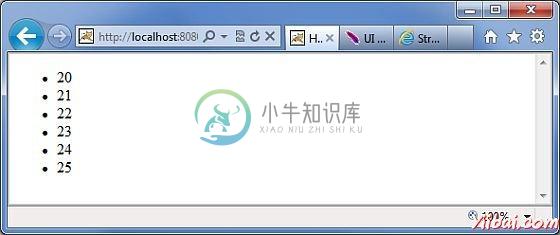Struts2 bean 标签
精华
小牛编辑
114浏览
2023-03-14
bean标签的设置和push 标签的组合,它可以创建一个新的对象实例,然后设置变量的值。然后,它的bean可以在值栈,因此,它可用于在JSP页面。
bean标签需要一个Java Bean来工作。所以,标准的java bean规律应遵循。这是bean 应该有一个无参数的构造函数。要公开和使用的所有属性的getter和setter 方法。对于这个练习的目的,让我们用下面的计数器类,在struts util包。Counter 类是一个bean,可以使用一个计数器来跟踪。
因此,让我们所有的文件保持不变,并修改的helloWorld.jsp文件。
创建动作类:
package com.yiibai.struts2; public class HelloWorldAction{ private String name; public String execute() throws Exception { return "success"; } public String getName() { return name; } public void setName(String name) { this.name = name; } }
创建视图
让我们包含以下内容 helloWorld.jsp:
<%@ page contentType="text/html; charset=UTF-8" %> <%@ taglib prefix="s" uri="/struts-tags" %> <html> <head> <title>Hello World</title> </head> <body> <s:bean name="org.apache.struts2.util.Counter" var="counter"> <s:param name="first" value="20"/> <s:param name="last" value="25" /> </s:bean> <ul> <s:iterator value="#counter"> <li><s:property /></li> </s:iterator> </ul> </body> </html>
接下来让我们有employees.jsp包含以下内容:
<%@ page contentType="text/html; charset=UTF-8"%> <%@ taglib prefix="s" uri="/struts-tags"%> <html> <head> <title>Employees</title> </head> <body> <p>An example of the include tag: </p> <s:include value="HelloWorld.jsp"/> </body> </html>
配置文件
你的struts.xml应该像这样:
<?xml version="1.0" encoding="UTF-8"?> <!DOCTYPE struts PUBLIC "-//Apache Software Foundation//DTD Struts Configuration 2.0//EN" "http://struts.apache.org/dtds/struts-2.0.dtd"> <struts> <constant name="struts.devMode" value="true" /> <package name="helloworld" extends="struts-default"> <action name="hello" class="com.yiibai.struts2.HelloWorldAction" method="execute"> <result name="success">/HelloWorld.jsp</result> </action> <action name="employee" class="com.yiibai.struts2.Employee" method="execute"> <result name="success">/employee.jsp</result> </action> </package> </struts>
web.xml中应该像这样:
<?xml version="1.0" encoding="UTF-8"?> <web-app xmlns:xsi="http://www.w3.org/2001/XMLSchema-instance" xmlns="http://java.sun.com/xml/ns/javaee" xmlns:web="http://java.sun.com/xml/ns/javaee/web-app_2_5.xsd" xsi:schemaLocation="http://java.sun.com/xml/ns/javaee http://java.sun.com/xml/ns/javaee/web-app_3_0.xsd" id="WebApp_ID" version="3.0"> <display-name>Struts 2</display-name> <welcome-file-list> <welcome-file>index.jsp</welcome-file> </welcome-file-list> <filter> <filter-name>struts2</filter-name> <filter-class> org.apache.struts2.dispatcher.FilterDispatcher </filter-class> </filter> <filter-mapping> <filter-name>struts2</filter-name> <url-pattern>/*</url-pattern> </filter-mapping> </web-app>
右键点击项目名称,并单击Export > WAR File创建一个WAR文件。然后部署此WAR在Tomcat的webapps目录下。最后,启动Tomcat服务器和尝试访问URL http://localhost:8080/HelloWorldStruts2/hello.action。这会给出以下画面:

在这个例子中,我们实例化一个新的org.apache.struts2.util.Counter bean实例。然后我们的第一个属性设置为20和25最后一个属性。这意味着计数器的值分别为20,21,22,23,24和25。我们给一个名为“Counter”的bean。 struts的bean标签将bean实例化,并把它值栈中的。现在我们可以使用迭代器去,通过计数器bean的nd打印出计数器的值。.
